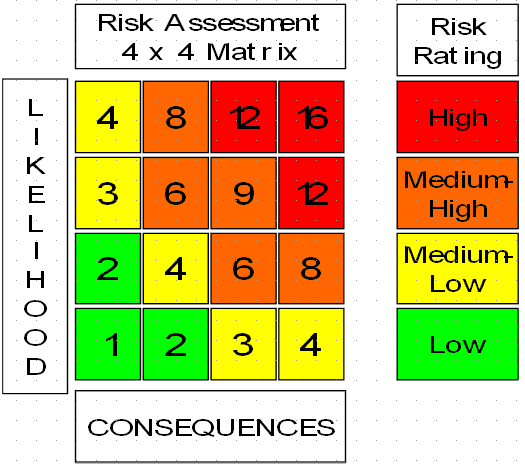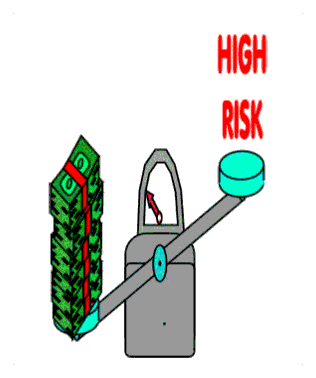|
|
4x4 Risk MatrixSend comments on this topic |
FREE QHSE Software Click <HERE> to Learn More |
||
QHSE Support >(Site Map) Health & Safety Guidance > Risk Assessments >
Health and Safety Risk Assessments - Sample 4x4 Risk Assessment Matrix
The matrix works by selecting the appropriate consequences from across the bottom, and then cross referencing against the row containing the likelihood, to read off the estimated risk rating.
Likelihood (Probability)
4. Likely or frequent (likely to occur, to be expected)
3. Probable (not surprised, will occur in given time)
2. Possible (could occur occasional)
1. Extremely Remote (unlikely, though possible)
Severity (Impact)
4. Fatality, Major Injury (imminent danger exists, hazard capable of causing death and illness on a wide scale)
3. Serious Injury (hazard can result in serious injury and/or illness, property a equipment damage)
2. Minor Injury (hazard can cause illness, injury or equipment damage but the results would not be expected to be serious)
1. Trivial or Negligible (hazard will not result in serious injury or illness, remote possibility of damage)
The 4x4 Risk Assessment Matrix
The colours red, amber, yellow and green reflect varying levels of overall risk with green and yellow being generally acceptable (normally subject to monitoring), amber being of cause for caution and concern and red being of significant concern.
The matrix sets out the suggested criteria for assessing the likelihood and consequences to produce an overall score.
Risk Rating is calculated by multiplying the likelihood against the consequences, e.g. taking a likelihood of 3 which is classified as Probable (do not be surprised, it will occur in given time), and multiplying this against a consequence of 2 which is classified as a Minor Injury (hazard can cause illness, injury or equipment damage but the results would not be expected to be serious), would give you and overall risk rating of 6, which is the first risk rating to be classified as a medium-high.
Multiplying the Likelihood by the Consequences allows an easy identification of the risk rating.
Suggested actions as to what to do with the Risk Rating scores.
If the Risk Rating is between
Score 1 or 2 - Low, Continue with existing control, however monitor for changes
Score 3 or 4 - Medium Low, Requires attention to reduce the rating and regular ongoing monitoring
Score 6, 8 or 9 - Medium High, Requires immediate attention to bring the risk down to an acceptable level
Score 12 or 16 - High, Stop immediately? Risk is too high and not acceptable
Help file v2.276.407 : QHSE Support - Website On Safe Lines
onsafelines.com QHSE Software 2025 : Webmaster: Brian G. Welch MSc(QHSE), NVQ4(OH&S), CMIOSH




